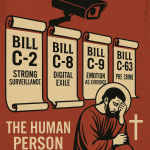Miles Smit says a leftover seating plan for the French parliament has outlived its usefulness as political metaphor. Fortunately, the Church offers abundant replacements.
Few mental traps seem as innocuous as the herding of our political instincts, energies, and ideas into the pens of the Left-Right distinction. Yet the very soft commonality of the terms makes them all the more obscuring – and damaging.
“Right” and “Left” are used as proxies for free markets versus. socialist alternatives, conservative versus. liberal, Tradition versus. Progress etc. We owe the idea to the seating arrangement of the National Assembly in Paris following the French Revolution, from which time it has become a placeholder for parties that favour either “order” or “movement.”
But surely, it might be argued, both order (as the perquisite of justice), and movement (as a living energy that can meet the changing demands of prudence) are essential? True enough, except that the divided French National Assembly post-1789, and the polarized politics it influenced, came after grievous loss of the socially and politically necessary counsel the Church can offer.
Fast forward to the available political options in 2025 Canada and it is increasingly obvious, both to intuition and on analysis, that the ideas and leadership needed to address what ails us are simply not on offer. Yet no one would have much trouble scoring the major parties from left to right. What true principles do they really advance?
If the left-right polarity was ever serviceable, it has surely outlived its day. Indeed it is in many ways intolerably costly.
Not only is the divide unhelpful for capturing real issues and options, it has a divisive logic that pits brother against brother. Indeed it often looks as if that is the point: left and right narratives protect unjust aggregations of power by concealing the actual interests and mechanics of the regimes we live under, and create antagonistic, adversarial dynamics that thwart natural and emerging fraternity.
In Canada, which suffers from weak fraternity and a poverty of positive common identity, this adversarial – and ultimately fratricidal – logic is especially costly.
Further, by emphasizing orientation by opposed camps, it has a tendency to suffocate the pursuit of grounded, durable and possibly unifying principles.
What is the most promising vector of escape from the traps of a false L – R divide? Surprisingly to some, the answer increasingly looks like a reinvigoration of our social covenant in keeping with the principles of Catholic social teaching.
The basic principles of this approach include the conviction that all the private and worldly goods of a society cannot be rightly assessed without a strong awareness of the common good, and an orientation of that shared good to the highest and most spiritual Good. It also contains at least two axioms of justice:
Solidarity, which tells us that the welfare of each person in a political entity such as a nation, including the weakest, and those who do not (yet) have a public voice, is inviolable and of great importance, and;
Subsidiarity, which holds that individuals, families, small communities and other intimate circles must remain empowered to determine everything within the sphere of their competence.
Those two principles might seem incompatible, but the stark reality is that societies such as Canada’s are often low in both solidarity and subsidiarity. Individuals, families etc. are neither furnished with flourishing in basic material or spiritual goods by the common good, nor are they free to acquire and cultivate these goods on their own.
On the one hand, we are our brothers’ keeper, and their want of essential goods is a social and political problem. On the other hand the prerogatives of smaller circles of intense attachment, from private property to family rearing are sacrosanct. If that is so, why are politicians who meaningfully promote this balanced picture scarcely to be found?
The question brings us back to the hopefulness of our present moment. The answer is that new grassroot trends include hopeful shoots. Once-unchurched men and women, troubled by the turbulent darkness of the secular world, are swimming towards Catechism classes as the only “ship on the horizon.” Similarly the Church itself, once casually dismissed as irrelevant, is increasingly identified as the only truly catholic, that is, broad, inclusive and universal, hub of belonging that can unite mankind in a globalized, connected, yet wearied and precarious world.
The Church offers uniquely valuable, humane answers to social problems, and in some cases, the only answers. Given Her Divine mandate, this is to be expected, but there are many tokens evident to common sense, from the Church’s nonpareil network of social services worldwide, to the useful example of political pluralism found in medieval Catholic societies.
If the fulfillment of this promise seems remote, it is in truth certainly a large development only beginning truly to sprout up. But a growing number of people see a meaningful and substantial expression of political Catholicism as not only salubrious and necessary for all, but inevitable.






